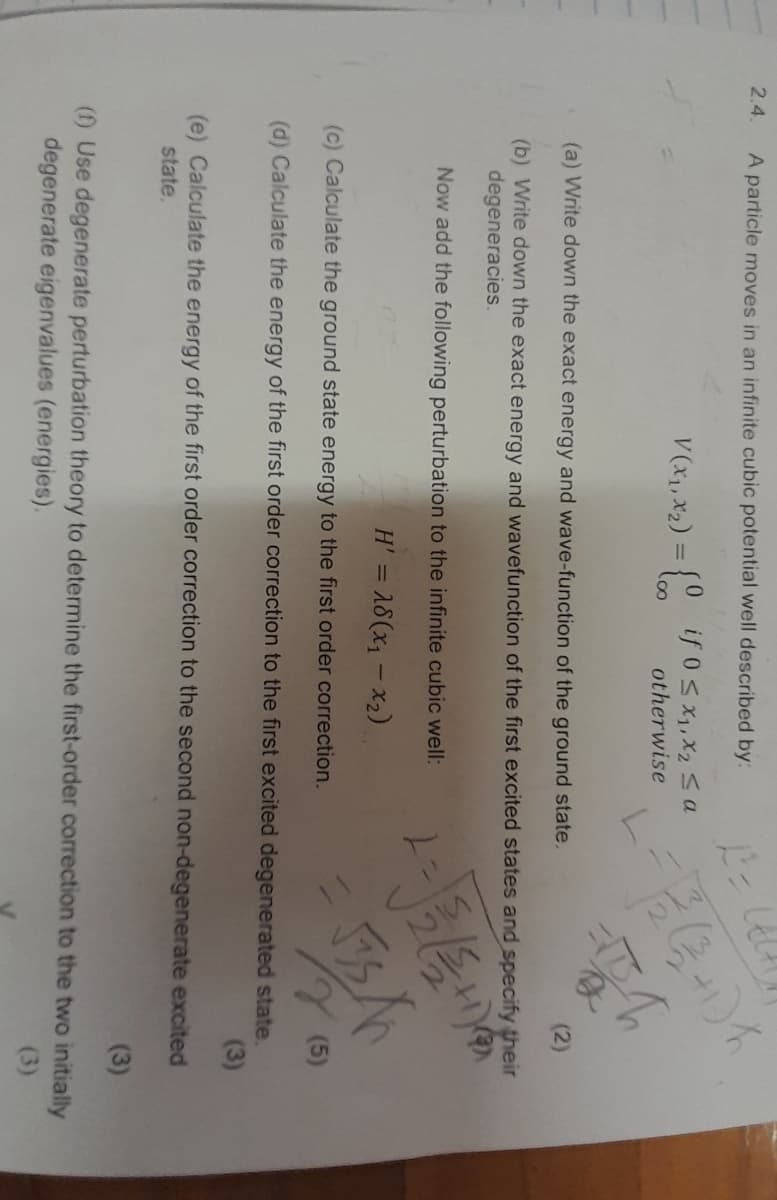2.4. A particle moves in an infinite cubic potential well described by: V(x1, x2) = {0 if 0 ≤ x1, x2 ≤ a otherwise 12= (a) Write down the exact energy and wave-function of the ground state. (2) (b) Write down the exact energy and wavefunction of the first excited states and specify their degeneracies. Now add the following perturbation to the infinite cubic well: H' = 18(x₁-x2) (c) Calculate the ground state energy to the first order correction. 2 (5) (d) Calculate the energy of the first order correction to the first excited degenerated state.
2.4. A particle moves in an infinite cubic potential well described by: V(x1, x2) = {0 if 0 ≤ x1, x2 ≤ a otherwise 12= (a) Write down the exact energy and wave-function of the ground state. (2) (b) Write down the exact energy and wavefunction of the first excited states and specify their degeneracies. Now add the following perturbation to the infinite cubic well: H' = 18(x₁-x2) (c) Calculate the ground state energy to the first order correction. 2 (5) (d) Calculate the energy of the first order correction to the first excited degenerated state.
Related questions
Question

Transcribed Image Text:2.4.
A particle moves in an infinite cubic potential well described by:
V (x1, x2) = {00
12=
if 0 ≤ x1, x2 a
otherwise
1/2(+1)
(a) Write down the exact energy and wave-function of the ground state.
(2)
(b) Write down the exact energy and wavefunction of the first excited states and specify their
degeneracies.
Now add the following perturbation to the infinite cubic well:
H' = 18(x₁-x2)
(c) Calculate the ground state energy to the first order correction.
(5)
(d) Calculate the energy of the first order correction to the first excited degenerated state.
(3)
(e) Calculate the energy of the first order correction to the second non-degenerate excited
state.
(3)
(f) Use degenerate perturbation theory to determine the first-order correction to the two initially
degenerate eigenvalues (energies).
(3)
Expert Solution
This question has been solved!
Explore an expertly crafted, step-by-step solution for a thorough understanding of key concepts.
Step 1: Given data and to find:
VIEWStep 2: Calculation of exact ground and first excited state energy and wavefunction i.e part (a) & (b)
VIEWStep 3: Calculation of part (c) i.e ground state energy to first order correction
VIEWStep 4: Calculation of part (d) i.e degenerated 1st excited state energy to 1st order correction
VIEWSolution
VIEWStep by step
Solved in 5 steps with 5 images
